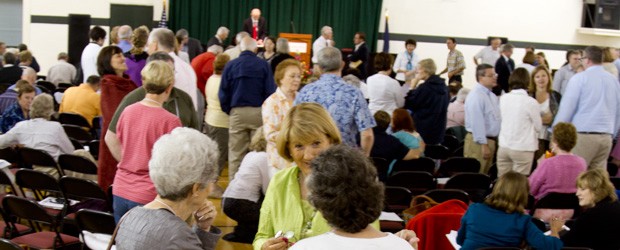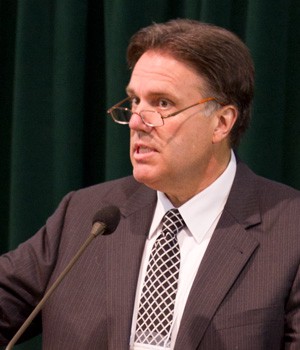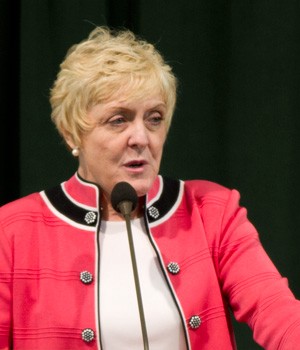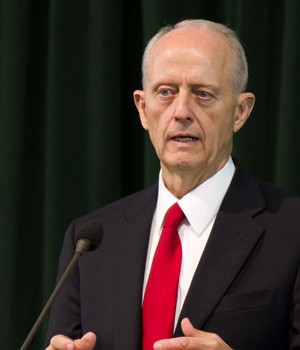Archived
Coming to Know Christ, His Prophets, His Holy House

The second day of the 16th Annual Education Conference at Southern Virginia University on Saturday, June 2, featured presentations on the journey to know Christ personally, and to learn from his plan, his prophet on the earth today and his holy temples.
Presenters addressing the theme, “Journey to Higher Ground,” on the second day of the conference included: David J. Ridges, author and Church Educational System instructor; Brad Wilcox, author and professor of education at Brigham Young University; Heidi S. Swinton, author of “To the Rescue: The Biography of Thomas S. Monson”; and Elder John M. Madsen, an emeritus member of the First Quorum of the Seventy of The Church of Jesus Christ of Latter-day Saints.
David J. Ridges
Ridges continued his presentation from the previous day about the plan of salvation and how it serves as a map to higher ground. He focused this presentation on prophecies surrounding the second coming of the Savior and the millennium.
As on the first day of the conference, Ridges focused on utilizing the scriptures as well as revealed doctrine from modern prophets and correlated material. He addressed common questions about the latter days and offered answers based on doctrine.
“The wicked will be caught off guard, but the righteous will not be,” said Ridges. “They will know the sign of the times and they will be aware that it’s imminent.”
Ridges finished his presentation by saying that the plan of salvation is a “glorious part of our journey to achieving higher ground.” He urged attendees to follow the plan by leading a righteous lifestyle.
“Righteousness is the simplest and by far most satisfying of all lifestyles,” he said.

Brad Wilcox
Wilcox, who previously served as a member of the Sunday School general board of the LDS church, spoke about many of the names and titles of the Savior in an effort to know them — and him — better.
“Not only are we commanded to do things in the name of Jesus Christ, but we are commanded to know the name of Jesus Christ,” he said. “
Wilcox said that understanding the meanings of Christ’s roles, and the differences between them, is important in order to come to know the Savior. For example, he made a distinction between the roles of Savior and Redeemer. He said that Christ’s saving role “puts us on firm ground “ and his redeeming role “moves us to higher ground.”
“Why do we need to go through afflictions and illness and trials?” Wilcox asked. “The answers to all those questions come to us as we move beyond Jesus’ saving role to his redeeming role. He can refine us. He can rebuild us. He can make us better than before. It is one thing to be saved by grace and another thing entirely to be transformed by grace.”
After speaking about many of Christ’s names and titles, Wilcox shared his favorite of all of Christ’s names: Emmanuel, which means, “God with us.”
“When we are baptized and make a covenant, immediately we are given the Holy Ghost to be with us always,” he said. “When we are in the temple and make a covenant, immediately Jesus stretches forth his hand and takes our hand and helps us keep that covenant.”

Heidi S. Swinton
Swinton spoke about her experiences with President Monson from interviewing him, reading every published address he has ever given and interacting with him on a personal level.
She asked the attendees to think about how they have been influenced by the teachings of President Monson and how his calling has changed their lives and “added to [their] understanding of what the Lord would have [them] do to journey to higher ground.”
She told the story of how she received a phone call from President Monson while she was baking cookies for missionaries in the England London South Mission — where her husband served as mission president from 2006 to 2009.
After taking the time to talk to her about her mission in England, President Monson — who had received a number of suggestions of potential biographers, discussed the matter with his wife, Frances, and prayed about whom to choose — said that he felt Swinton was the right person to write his biography.
“I carried the weight on my shoulders of writing about the prophet of God,” said Swinton. “I will never be casual about the power of the prophet in our lives today — the significance of having a prophet who can see farther than we can see and who can hear the lord speaking to all of us.”
She said that in her experience with the prophet, she has noticed that he always has a great concern for the individual, and always follows the promptings of the Spirit to bless the lives of those around him. She told a number of stories from President Monson’s life that highlighted these traits and show us how we can be better at going “to the rescue” of those around us.
“Every story [President Monson tells] is based in a doctrine of Jesus Christ — a doctrine that if we take into our hearts and get just a little bit better at, we will find ourselves closer and closer to our Father in Heaven and fulfilling the charge to do the Lord’s work,” she said. “[President Thomas S. Monson’s] journey has been about coming closer to Jesus Christ by learning of him, believing in him, trusting him and following him.”

Elder John M. Madsen
Elder Madsen spoke about the temple — saying, like the late Elder Joseph B. Wirthlin, that the temple is the higher ground we’re all seeking. He quoted Elder Robert D. Hales, who said the temple is “the highest ground we can achieve in mortality.”
“So our journey… to higher ground doesn’t have to be to foreign countries, cultures and continents,” Elder Madsen said. “Our journey really has to be to the nearest temple.”
He shared passages from “Preparing to Enter the Holy Temple,” a booklet based on “The Holy Temple” by President Boyd K. Packer. He read, that “to endow is to enrich” and to give something of “much worth” to another. He also quoted the late President David O. McKay, who defined the temple endowment as “a step by step ascent into the eternal presence.”
“No work is of a greater protection to this church than temple work and the genealogical research that supports it,” said Elder Madsen. “No work is more spiritually refining. If we enter into our covenants without reservation or apology, the Lord will protect us. We will receive inspiration sufficient for the challenges of life.”
He urged all those present to “claim the blessings of the holy temple” and receive the “gift that will give forever.” He also shared a number of scriptural passages about temples to describe their eternal significance.
“Doctrine and Covenants 36:8 speaks volumes to me: ‘I will suddenly come to my temple,’” he said. “Be temple worthy because the Lord is going to suddenly come to his temple. Be worthy to enter into that holy place to go as often as circumstances allow.”
 News
News